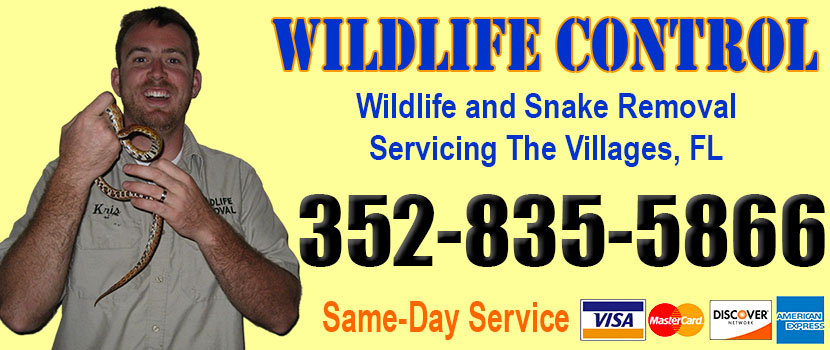
Welcome to thevillagessnakes.com! I am David, a snake enthusiast living in The Villages, FL. Many people don't know that The Villages is in fact full of snakes! You just need to know where to find them - they can often be shy and elusive. Some Florida snake species are more common outside of the city limits, in different parts of Sumter County FL, but many types of snakes are indeed common in the more urban parts of The Villages. This guide is meant to help educate you about the beautiful snakes of The Villages, and to help you identify the most common snakes of The Villages, as well as the venomous snakes of The Villages that you should learn to recognize and avoid. If you want more detail, click here for my complete list of ALL snake species in The Villages. Remember the following:
- Most snakes of The Villages are harmless and don't want to encounter you
- Venomous snakes exist but are uncommon in The Villages, Florida
- Snakes eat rats and mice and are a valuable part of the Florida ecosystem
- Never kill a snake - if you leave a snake alone, it will leave you alone.
Common Snake Species in The Villages
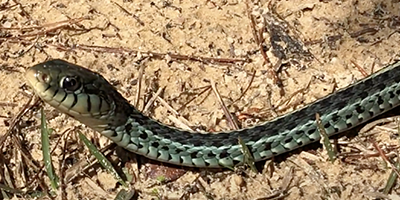 Eastern Gartersnake/ Blue-striped Gartersnake:
Eastern garter snakes are usually black, greenish-brown, tan, and sometimes gray. They also usually have one long stripe running down their back. They also possess three thin stripes around the length of their bodies. These stripes tend to be yellow, blue, white, brown, or green. There are occasions however where they lack the stripes. These snakes can range from 18-26 inches in length.
Eastern Gartersnake/ Blue-striped Gartersnake:
Eastern garter snakes are usually black, greenish-brown, tan, and sometimes gray. They also usually have one long stripe running down their back. They also possess three thin stripes around the length of their bodies. These stripes tend to be yellow, blue, white, brown, or green. There are occasions however where they lack the stripes. These snakes can range from 18-26 inches in length.
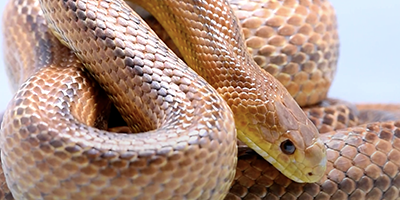 Everglades Rat Snake:
This species’ name comes from its usual sightings in Florida’s Everglades National Park, where they like to bask in the sun and rest and then hunt for their prey at night. They can also be called a variety of names, including eastern rat snake and chicken snake. Adults have an average length of around 40 to 75 inches in total length, and one can identify them by their yellow, tan, orange, or gray coloration. Although their coloration has multiple varieties, you can always spot dark spots marring their backs. Everglades rat snakes like to climb up trees, where they are often found. However, they are also superb swimmers and will retreat in the water when cornered or threatened. They commonly feed on lizards, frogs, birds, and bird eggs, and they are not harmful to humans.
Everglades Rat Snake:
This species’ name comes from its usual sightings in Florida’s Everglades National Park, where they like to bask in the sun and rest and then hunt for their prey at night. They can also be called a variety of names, including eastern rat snake and chicken snake. Adults have an average length of around 40 to 75 inches in total length, and one can identify them by their yellow, tan, orange, or gray coloration. Although their coloration has multiple varieties, you can always spot dark spots marring their backs. Everglades rat snakes like to climb up trees, where they are often found. However, they are also superb swimmers and will retreat in the water when cornered or threatened. They commonly feed on lizards, frogs, birds, and bird eggs, and they are not harmful to humans.
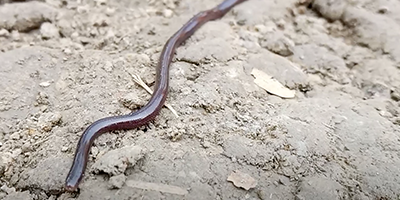 Brahminy Blind Snake:
Also called the flowerpot snake, they are also the smallest known snake species in the world. Brahminy blind snakes are very small and thin snakes that are often mistaken for earthworms. The difference between them and an earthworm is that earthworms have segments and the blind snake does not. You can also see their little tongues if you look closely. Brahminy blind snakes have an average adult length of 4 to 7 inches in total, and they often have a varying coloration of silvery gray, deep gray, or deep purple. These snakes are not native to Central Florida, and they are commonly found in Southern Asia until one was spotted in Miami, Florida. Now, they are usually found all over the state. Because of their small size, their diet consists of the eggs and larvae of ants and termites.
Brahminy Blind Snake:
Also called the flowerpot snake, they are also the smallest known snake species in the world. Brahminy blind snakes are very small and thin snakes that are often mistaken for earthworms. The difference between them and an earthworm is that earthworms have segments and the blind snake does not. You can also see their little tongues if you look closely. Brahminy blind snakes have an average adult length of 4 to 7 inches in total, and they often have a varying coloration of silvery gray, deep gray, or deep purple. These snakes are not native to Central Florida, and they are commonly found in Southern Asia until one was spotted in Miami, Florida. Now, they are usually found all over the state. Because of their small size, their diet consists of the eggs and larvae of ants and termites.
Venomous Snake Species in The Villages
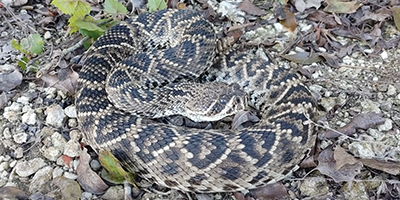 Eastern Diamondback Rattlesnake:
This snake species is the largest venomous snake in Florida, and its length can exceed 6 feet in total. This snake is highly dangerous and should never be approached in any instance. One can identify an eastern diamondback rattlesnake by their bold marking of dark-colored diamond patterns with brown centers that are bordered by a light dirty white or cream-colored border. They usually have a dark facial color that is bordered by a light cream color the same as their body. This snake can usually be found in dry habitats such as golf courses, pinelands, and scrubs. Like the name suggests, their tail ends have a rattle that emits a loud buzzing and rattling sound when the snake feels threatened or cornered. Luckily, this can also be a warning that they are poised to strike. Unfortunately, not all rattlesnakes rattle before striking, so one should still avoid these snakes at all costs. Their diet consists of medium-sized prey like rabbits and squirrels.
Eastern Diamondback Rattlesnake:
This snake species is the largest venomous snake in Florida, and its length can exceed 6 feet in total. This snake is highly dangerous and should never be approached in any instance. One can identify an eastern diamondback rattlesnake by their bold marking of dark-colored diamond patterns with brown centers that are bordered by a light dirty white or cream-colored border. They usually have a dark facial color that is bordered by a light cream color the same as their body. This snake can usually be found in dry habitats such as golf courses, pinelands, and scrubs. Like the name suggests, their tail ends have a rattle that emits a loud buzzing and rattling sound when the snake feels threatened or cornered. Luckily, this can also be a warning that they are poised to strike. Unfortunately, not all rattlesnakes rattle before striking, so one should still avoid these snakes at all costs. Their diet consists of medium-sized prey like rabbits and squirrels.
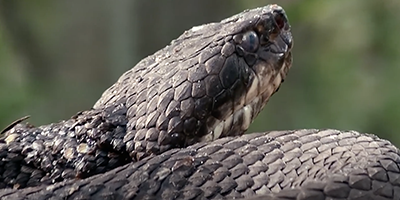 Water Moccasin:
The water moccasin or cottonmouth is the only venomous water snake in North America. These snakes have large mouths paired with long and venomous fangs. They also have a tendency to strike without warning due to their short tempers, but they rarely bite humans. These snakes tend to slither into pools and other places with water, so always make it a point to canvas the whole area before dipping yourself in water. If you see a water moccasin, lock yourselves indoors and call animal control services. Never attempt to catch them yourselves. One can identify a water moccasin through their large jowls and cat-eye-like pupils. They also have dark stripes in their nostrils and a pale snout, with a large, triangular head and a thin neck. Their coloration can vary from anywhere between dark chocolate brown and black, to olive or yellow.
Water Moccasin:
The water moccasin or cottonmouth is the only venomous water snake in North America. These snakes have large mouths paired with long and venomous fangs. They also have a tendency to strike without warning due to their short tempers, but they rarely bite humans. These snakes tend to slither into pools and other places with water, so always make it a point to canvas the whole area before dipping yourself in water. If you see a water moccasin, lock yourselves indoors and call animal control services. Never attempt to catch them yourselves. One can identify a water moccasin through their large jowls and cat-eye-like pupils. They also have dark stripes in their nostrils and a pale snout, with a large, triangular head and a thin neck. Their coloration can vary from anywhere between dark chocolate brown and black, to olive or yellow.
If you're unsure, you can email me a photo of the snake at info@thevillagessnakes.com and I will email you back with the snake's species. If you found a snake skin, read my Found a Skin? page, and you can email me a photo of the skin, and I'll identify the snake for you. If you need professional The Villages snake removal help, click my Get Help page, or see the below website sponsor I found, who provides that service.
Do Snakes Lay Eggs Or Give Live Birth?
Some people are unsure of how snakes reproduce. Without personal knowledge of snakes or experience with them, this is understandable. Others, though, may think all snakes go one way or the other with reproduction. Since imagery of snakes laying and protecting eggs is most common, most assume that snakes are egg-laying animals. However, that is not always the case. Snakes can, and typically do, lay eggs, but not all will. Some snakes give live births. Whether a snake does one or the other oftentimes depends on where it lives. Snakes have evolved to give birth based on their climate to ensure they can reproduce.
Snake Birth
Egg-laying snakes are the most common. About 70% of snakes lay eggs, and the rest give live birth. This is why most people associate snakes with laying eggs. They are the most common type of snake and they are what most people see. Whether a snake lays eggs or gives live birth depends on where it lives. Snakes in warmer climates lay eggs, whereas the snakes in cooler climates are going to give live birth. The reason for this is simple – warmth. Eggs require warmth to develop and hatch. Eggs cannot provide the necessary warmth to the eggs themselves, so they rely on their environment for that. In warm environments, like the southern United States and much of South America, this is not a problem. They have plenty of areas where they can lay eggs and let them incubate. For snakes in cool environments, there is no way for them to provide warmth to their eggs. If they were to lay eggs, the eggs would not develop and the snakes would not be able to reproduce. They have evolved to reproduce through live birth, giving birth to young directly like most mammals do.
Survival
Both give birth these ways as a means of survival. This allows them to reproduce and continue living, as a species, better than they could otherwise. Due to the differences in climate, their births are what fit them best.
Snake births depend entirely on where the snakes are. If you are curious about whether a specific type of snake will give a live birth or lay eggs, consider where the snake comes from. How it will give birth depends entirely on whether it typically lives in cool or warm climates. Whether Europe or South America, it remains the same everywhere.
Remember, the term is not poisonous snakes of The Villages, it's venomous snakes of The Villages. Poison is generally something you eat, and venom is injected into you. That said, dangerous snakes are very rare in The Villages. The few venomous snakes of Sumter County are rarely seen. But they are commonly misidentified, so learn about all the snake species of The Villages in order to correctly identify them. These snakes are usually also found in the surrounding towns of Leesburg, Tavares, Mount Dora, Belleview, Summerfield, Ocklawaha, Oxford, Lady Lake, Fruitland Park, Oxford, Wildwood, Adamsville, Coleman, Okahumpka, and the surrounding areas.
Read our article about:
Southern Hognose Snake
thevillagessnakes.com domain and hosting costs made possible by the generous support of this sponsor:
